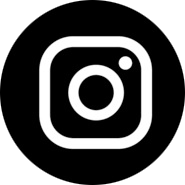CTA Green Line
Project Challenge — Chicago’s Garfield Boulevard Station is one of the oldest public transit stations in the United States, originally built in 1892 to ferry visitors from downtown Chicago to the 1893 World’s Columbian Exposition on the city’s south side. Nestled in a greenbelt formed by nearby Washington Park and the historic Garfield Boulevard, the station, which serves nearly half a million riders a year, received official landmark status from the city of Chicago in 2001. But over the decades, the area—and its CTA station—had deteriorated.
“Once home to an economically and ethnically diverse population, over the last 60 years the Washington Park neighborhood has experienced high vacancy, disinvestment, crime, and a steady decline in population,” explained Catherine Hosinski of the Chicago Transit Authority (CTA).
To revitalize the area, the nearby University of Chicago formed the Arts + Public Life Initiative’s Arts Block project—with the CTA station a “key component,” according to Hosinski—and tapped the renowned Chicago artist Theaster Gates to lead it. The neighborhood began to rebound. In 2013, Gates’s $1.8 million Arts Incubator was constructed next to the historic CTA stationhouse and, just two years later, land less than a mile away from the station was chosen as the site of the Obama Presidential Center.
And work on the Garfield station began, with the goal of “integrating multiple transportation modes, improving the operational stationhouse to make it a community gateway, and revitalizing the historic stationhouse for future use as community space,” as Hosinski described it. The station renovation would become “part of a larger, collaborative effort to catalyze economic development in the surrounding Washington Park neighborhood and increase the safety and quality of life for its residents.”
For the ambitious $43 million renovation project, funded in part by a $25 million TIGER (Transportation Investment Generating Economic Recovery) grant, the CTA hired the international architecture firm EXP, which had worked on multiple transit stations in past years, including the award-winning 95th Street terminal expansion and renovations. For the Garfield station, EXP’s Sara Fetterolf described an “overall station vision that included a material palette upgrade, developed with the CTA, to provide greater transparency of the station and a modern design aesthetic.” Importantly, EXP, working with Walsh Construction, also aimed “to enhance passengers’ experience by creating a unique identity that anchors the station to its particular place within the community”—an especially important point in such a historically significant neighborhood undergoing revitalization.
The station needed structural and engineering updates—extended platform canopies, a new communications system, improved escalators and elevators, and enhanced lighting and signage—but the CTA wanted to do more. It commissioned the internationally acclaimed Chicago artist Nick Cave and collaborator Bob Faust to “artistically enhance the architectural elements of the transit facility,” said Hosinski.
Together, the CTA, EXP, Walsh Construction, and Cave and Faust worked together—from initial station renderings through multiple collaborative design meetings—to bring about Cave’s “vision for an immersive experience that reflects the surrounding community,” as Hosinski described it. Cave and Faust created a kaleidoscope of bold, riotous designs for the station derived in part from Cave’s “sound suits”—one of his signature projects that conceals personal identities in a welter of sounds, colors, and textures animated by the wearers.
At the CTA station, Faust and Cave translated this visual vocabulary and sense of motion into a lush mosaic ceiling that morphs into an abstract pattern on the backwall facing the turnstiles, windbreaks on the platforms, and decorations on lenticular columns and the exteriors of the elevator towers. Vibrantly colored, the designs were intended to be appreciated not only by transit riders but also by those on the street below the station—the residents of the neighborhood the station serves.
“The heart of what makes them great is that they love art as much as we do, and they ensure its intention is met in the grandest way.” —Cave and Faust
Our Solution — The aesthetic component of the station renovation posed a number of challenges. The materials chosen had to be durable enough for a busy transit station subject to extreme temperatures yet also flexible enough to serve as Cave and Faust’s “canvas.” And the architects and designers had to balance the CTA’s mandate for visibility and safety with the richness of the artistic vision.
Glass proved to be EXP’s material choice for this high traffic public transit project. Skyline Design was selected to produce two separate components of the Garfield project: the windbreak stations on the platforms and the highly visible backwall, an architecture and design element that would be seen by anyone entering or exiting the station. Skyline Design was chosen by EXP, according to Fetterolf, because it could provide “the quality of graphic representation we needed for the artwork while ensuring durability for a public transit application.”
The four windbreak stations on the platform—composed of five panes of glass each—protect CTA riders from Chicago’s brutally cold winters and blazingly hot and bright summers. Skyline Design had to ensure that the process it used would withstand the extremes of Chicago’s weather, meet the CTA’s mandate for transparency, and do justice to Cave and Faust’s intricate, highly saturated, and color-rich designs. Fully opaque glass panels would not meet the CTA’s security requirements, and transparent panels would not achieve Cave and Faust’s aesthetic or preserve the integrity of their designs. For the windbreaks, Skyline Design produced ½” tempered laminated Starphire Safety Glass with a custom printed interlayer.
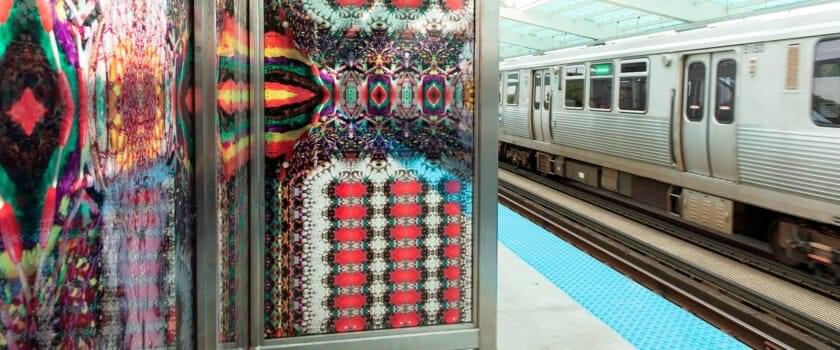
In all, Skyline produced 20 laminated glass units, each with individual pattern and color variations in the printed interlayers. Skyline Design’s printing process was able to capture the color saturation, nuanced detail, and luminosity of the designs while achieving graphic continuity across the individual laminated units, separated in the windbreaks by metal frames. The printed interlayers in the impact-resistant glass units were made with EVA (ethylene vinyl acetate) film rather than traditional PVB (polyvinyl butyral) film. EVA interlayers are emerging as a more durable alternative to those made with PVB; they are not only more resistant to moisture, heat and discoloration, but they also block 99% of UV rays—an important consideration for an outdoor application.
The interior of the station required the same level of durability and resistance to exposure. For the ceiling of the station, Cave and Faust designed an idyllic pattern of birds and flowers on printed tiles, which, when it met the wall, “melted” into its constituent colors. For the wall, Skyline Design produced another exterior-grade laminated unit that had to be carefully aligned with the ceiling pattern.
Skyline Design production director David Wildfield spent many hours at the site, carefully marking the points at which the ceiling pattern would meet the interior wall so the two could be perfectly aligned. Unlike the laminated glass for the windbreaks, which required translucency for safety and visibility, the interior wall needed to be completely opaque. While Skyline had to navigate the relationship between visibility and color saturation for the windbreaks, it also had to navigate the meeting of two complex but opaque patterns for the interior. Skyline Design’s laminated glass could be fabricated for use in both the station’s interior and exterior applications, while being customized for each—opaque inside the station, and translucent for the exterior windbreaks.
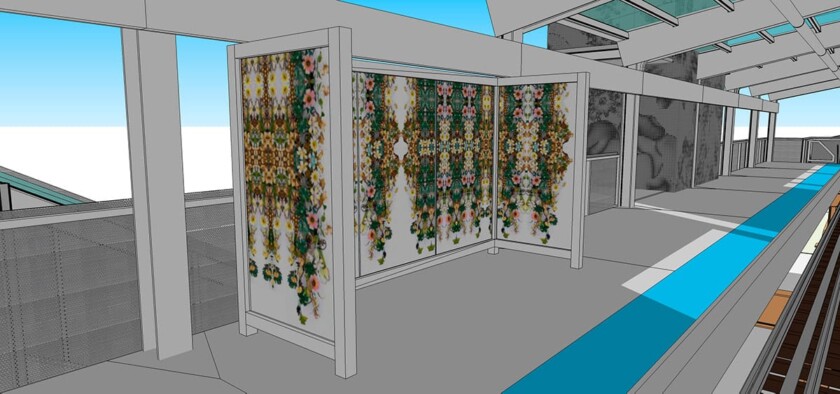

Result — Several years ago, Skyline Design invested in a suite of new machinery precisely for projects such as the CTA Garfield Boulevard station. Now able to produce laminated units (and do exterior frit printing), Skyline Design is proud to have worked on this historic project, which opens a new chapter in the company’s capabilities.
These new capabilities are accompanied by Skyline Design’s continued commitment to collaboration and superior client services. EXP’s Fetterolf appreciated Skyline Design’s flexibility and willingness to prepare multiple rounds of samples “to allow the artists to fully develop their vision and expression through Skyline’s material selection.” Stephen Specht, of Walsh Construction, elaborated, describing that “Skyline Design started by providing several different samples to our artists and architect to determine what best fit the needs of the project, then they were able to take sample files and produce even more samples so the artists could understand the clarity and sharpness of their printing.”
Specht also praised Skyline Design’s collaborative ethos, not just with the project team but also with subcontractors, writing that working with Skyline Design “was absolutely the easiest part of the aesthetic enhancement process.”
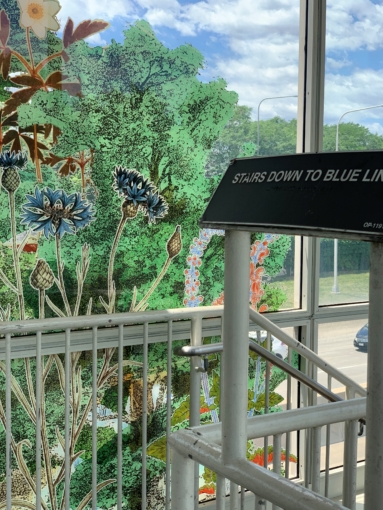
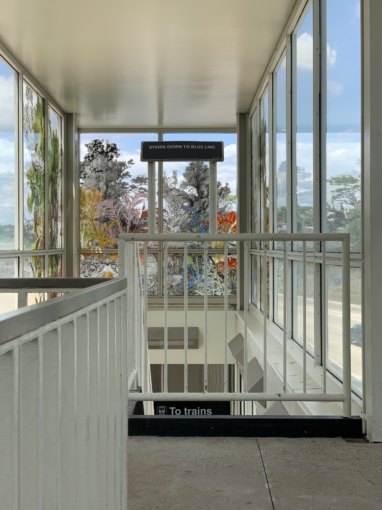
The January 2019 opening of the renovated station—with a ribbon cutting by then-mayor Rahm Emanuel—was covered locally, nationally, and even internationally, in the UK-based Art Newspaper.
Strikingly contemporary and bold, Cave and Faust’s designs were a highlight of the coverage. “The cumulative make-up of the Garfield Green Line’s art program was designed to activate the station in its entirety and perform immersively as an art installation would,” said Cave and Faust. “That said, all needed to integrate with the architecture and stand up to the extremely public purpose of the station. Skyline Design was a partner who understood that. While they produce with all safety and durability needs baked into their process, the heart of what makes them great is that they love art as much as we do, and they ensure its intention is met in the grandest way.”
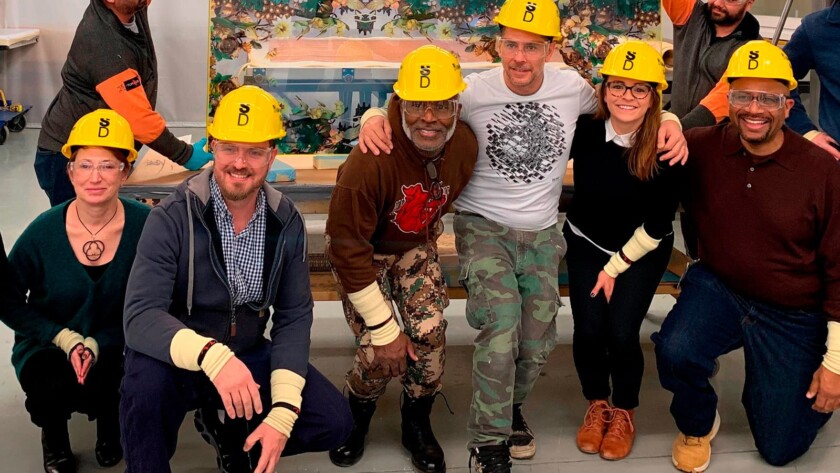
Stay in the Glass Loop
Get the latest Skyline news and product info delivered to your inbox.



